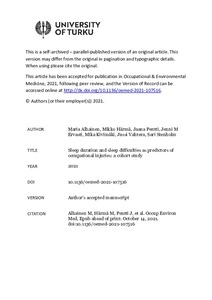Sleep duration and sleep difficulties as predictors of occupational injuries: a cohort study
Alhainen Maria; Härmä Mikko; Pentti Jaana; Vahtera Jussi; Kivimäki Mika; Stenholm Sari; Ervasti Jenni M
https://urn.fi/URN:NBN:fi-fe2022020818020
Tiivistelmä
Study objectives To examine the association between sleep duration and sleep difficulties with different types and causes of workplace and commuting injuries.
Methods The data were derived from the Finnish Public Sector study including 89.543 participants (178.309 person-observations). Participants reported their sleep duration and sleep difficulties between 2000 and 2012. These were linked to occupational injury records from the national register maintained by the Federation of Accident Insurance Institutions. Risk of injuries was followed up 1 year after each study wave. Logistic regression analysis with generalised estimating equations (GEEs) was used to examine the association between sleep duration/difficulties and risk of injuries, and multinomial logistic regression with GEE was used to examine the association with injury types and causes.
Results Both sleep duration and difficulties were associated with injuries. Employees with short sleep (<= 6.5 hours) had 1.07-fold odds of workplace injuries (95% CI 1.00 to 1.14) and 1.14 times higher odds of commuting injuries (95% CI 1.04 to 1.26) compared with employees with normal sleep duration. For employees with disturbed sleep, the corresponding ORs were 1.09-fold (95% CI 1.02 to 1.17) and 1.14-fold (95% CI 1.04 to 1.26) compared with those without sleep difficulties, respectively. The risk of commuting injuries was higher among those who had difficulty in falling asleep (OR 1.29, 95% CI 1.07 to 1.55), woke up too early (OR 1.11, 95% CI 1.00 to 1.23) or had non-restorative sleep (OR 1.18, 95% CI 1.05 to 1.33).
Conclusions Short sleep duration and sleep difficulties are associated with slightly increased risk of workplace and commuting injuries.
Kokoelmat
- Rinnakkaistallenteet [19207]
